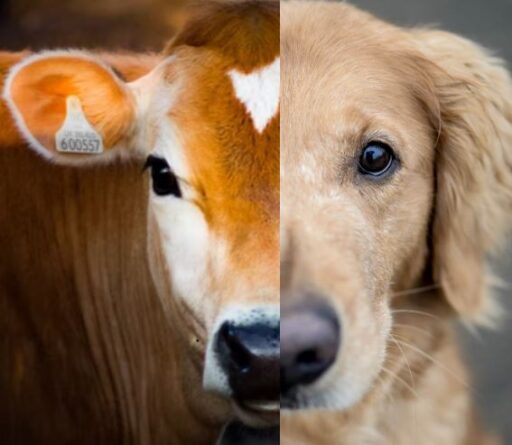Say you’re at a restaurant and saw the following on the menu: “Golden retriever burger. Certified humane killing.” How would you feel? Would you consider it humane for someone to kill a happy, healthy dog for food?
The reason we would not is because we have been socialized into an invisible belief system called carnism that teaches to view certain animals as companion animals and others as objects. This kind of thinking justifies killing non-human animals for food as “normal, natural and necessary.” Through it, we are desensitized to the reality of what we do to animals.
“Humane” means compassionate
To see through the fog of our conditioning, we must ask ourselves what “humane” really means. Synonyms include compassionate, kind, unselfish, gentle and merciful. It means lovingly. What about on a small family farm, where animals enjoy free reign outside until their final day?
If someone gave their dog several years of life like this, but then killed the dog for meat, would this be humane killing? We hold a double standard for companion animals versus farmed animals. They do not differ in any way but our perception of them.
Let’s put ourselves in their shoes. If a more intelligent being raised us with the intent of eventually killing eating us, would we think they loved us? Thus, we cannot humanely kill farmed animals unnecessarily any more than we can humanely kill our pets unnecessarily.
“Humane” treatment
Many people believe that non-human animals can be “humanely” raised for slaughter. They trust the marketing gimmicks that label the meat, dairy or egg products “cage free,” “grass-fed,” or “American Humane Certified.” The labels merely indicate less suffering, as even the labels with the highest standards still permit acts of cruelty, such as debeaking, ear notching, and castration without painkillers. Even these certifications still allow for killing the types of animals who are not useful to the industry, such as male chicks and male dairy cows.
As activist Ed Winters puts it, “If cruelty is defined as causing unnecessary and intentional physical or mental harm, what we do to animals must constitute acts of cruelty. We cut off their tails, we castrate them, we forcibly impregnate them, we take their babies away from them, we lock them in cages where they can’t turn around. We load them into trucks and take them to slaughterhouses where we cut their throats or force them into gas chambers – and these are just the standard, legal practices.”
“Humane” slaughter
Even if animals were treated humanely throughout their lives, the actual slaughtering of the animals is often very painful. Although factory farms attempt to stun the animals with a stun gun, the terrified animal is often thrashing about so much that it is ineffective. Regardless of whether they are conscious or not, cows, pigs and chickens continue in the slaughter line: hung up by their legs, bled out alive, skinned alive, sent into gas chambers, burned in scalding water alive.
Baby male chicks, useless to the egg industry, meet a slightly different fate. They are sent through pipes into electrified plates and wood chippers alive, as they not useful for the egg industry. On commercial fishing boats, fish are hooked on lines for hours and left to suffocate for several minutes.
Animals as individuals
We are also often unaware of the irony between our natural appreciation of animals and our eating habits. Parents take their kids to the petting zoo, then out to eat hamburgers. Families root for the animals in movies like Chicken Run and Finding Nemo, then eat chicken sandwiches and fish tacos. We are conditioned to view animals as one indistinguishable mass.
But what happens when one individual animal breaks away from a slaughterhouse? This very scenario occurred in England in 2019 with a cow the public nicknamed “Daisy.” The same people who would have eaten her in a burger pulled for her to escape. Most people wouldn’t want to have an animal they know individually killed for food, but can distance themselves from that reality when the animal is simply part of a nameless mass.
Animals are “someones,” not “somethings”
Many of us have rarely, if ever, interacted with farmed animals up close. But when we do so reflectively, we might question why we find it acceptable to kill them. As activist Ed Winters describes, “There is something profoundly moving about looking into the eyes of an animal. You recognize that behind those eyes is someone who is having an experience and through that recognition you can empathize with that experience.”
Because animals have subjective experiences, they are “someones.” Because they are not objects, they are not “somethings.” The more we know about individual animals, the more we recognize their individuality. Justifying why we kill them then becomes harder and harder. We realize that labeling what we do “humane killing” is just lying to ourselves to make ourselves feel better about it.
Are we against animal cruelty?
At the end of the day, we need to ask ourselves these four questions that Ed Winters poses:
- Am I against animal cruelty? (Everyone says yes.)
- What constitutes animal cruelty? Do you agree that it is causing *unnecessary* harm?
- Do we need to eat animal products to survive and thrive? (According to the World Health Organization, American and British Dietetic Associations, the Physicians’ Committee for Responsible Medicine, Dieticians for Professional Integrity and numerous academic journals – we don’t.)
- So, does eating animals constitute animal cruelty?
I’ll offer three thoughts on this one:
First, the social psychologist Melanie Joy wrote a book called Why Love Dogs, Eat Pigs, and Wear Cows. She explains how society conditions us to see animals differently based on their species, yet they do not differ in any way but our perception of them.
Have you ever noticed that we see our pets as individuals with personalities, but that society has conditioned us to view the animals we raise for food as one indistinguishable mass? Yet all animals have individual differences. Is there such thing as humane killing of an animal who does not wish to die?
Second, the philosopher Jeremy Bentham said, “The question is not, ‘Can they reason? Nor, Can they talk? But, ‘Can they suffer?”
Third, as Ralph Waldo Emerson put it, “However scrupulously the slaughterhouse is concealed in the graceful distance of miles, there is complicity.” To resolve this tension, we either have to change our beliefs or change our behaviors. We cannot honestly say we’re against animal cruelty while personally funding an industry antithetical to this value.


